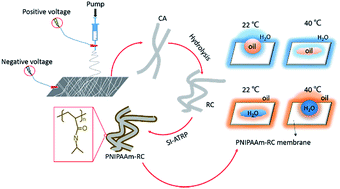Temperature-responsive nanofibers for controllable oil/water separation†
Abstract
Surface functionalization with stimuli-responsive materials can turn an ordinary material into a smart one that shows adaptive properties upon external stimuli. In this study, an electrospun regenerated cellulose (RC) nanofibrous membrane was firstly prepared; subsequently, poly(N-isopropylacrylamide) (PNIPAAm), a thermo-responsive polymer, was surface grafted to form the polymer chains/brushes on the surface of RC nanofibers via the surface-initiated atom transfer radical polymerization (SI-ATRP) method. Thereafter, the PNIPAAm-modified RC nanofibrous membrane was investigated for its temperature-responsive surface wettability at temperatures below/above the lower critical solution temperature (LCST). Furthermore, the nature of the hydrophilic/hydrophobic transitions of the modified nanofibrous membrane was also investigated through the water up-take and release experiment at various temperatures. Especially, as responses to different temperatures, the PNIPAAm-grafted nanofibrous membrane exhibits switchable super-lyophilic/super-lyophobic properties at a water–oil–solid three-phase interface. With the large surface area and switchable surface wettability, the as-prepared PNIPAAm-grafted nanofibrous membrane exhibits excellent properties of controllable oil/water separation, and possesses great potential towards both wastewater treatment and oil purification.


 Please wait while we load your content...
Please wait while we load your content...